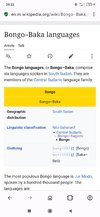The alchemist
VIP
He is wrong if he claims you specifically don't have Bantu-related ancestry. You do have a minor Bantu DNA showing on the models consistently. The deep West African-like ancestry is already nested within all Nilo-Saharans and is not the main reason you are showing extra Bantu. The proof of this is the clear Central African hunter-gatherer-derived signature you're showing. Again, it coincides with your people being from Uganda, consistent with the genetic evidence. I know this because you see it in the actual G25, modeling your DNA with a good fit.Oh okay, so it turns out I was mistaken, lol. And I'm Acholi.
This is a great reminder to appreciate just how frequently populations have moved around. And expectedly so, over the course of thousands of years. This was extremely informative, thank you so much
The Sudanic groups that intermingled with Kordofanians, such as the Nuba, whom we have samples of, even the groups with West African-specific DNA on the Saharan Nilo-Saharan side in the Central Sahara don't show these Mbuti-like levels you have. So, the only way for you to explain this is through a south-north admixture with a population that mediated it, plus the Bantu affinity is already evidence through signature and fit, making this all reconcilable through that pathway. If we replace the Bantu with Yoruba (which the Saharan groups pick up since West African groups mixed with Nilo-Saharans in Western Sahara), the fit turns worse noticeably for you. This means you don't have additional West African-mediated gene flow.
This is pretty robust.
We have an actual Ugandan Nilo-Saharan, albeit low resolution, that shows how this is consistent. Higher Bantu with other central African-originated DNA with no West African influence:
We have studies on Acholi showing Bantu signature and not West African as the source, as you can see in the admixture color scheme:
You see, if you had West African DNA, you would have a bulk that was blue color and not purple, which is Bantu.
The West African nested deep in the Nilo-Saharan lineage is a very different scenario. 23andMe might (because of the issue I told you about the dearth of sampling and relational parsing regarding your people on the database) inconsistently, without distinguishing between deep and more recent structure, pick up underlying things without acknowledging how it is basically, for the most part, an internal component and is not to be broken down and considered admixture, while at the same time, including Sudanic as separate when the whole thing is mostly Nilo-Saharan. You should not take a direct interpretive reading from them and internalize it. My model is way more accurate.
Last edited:


 Have a nice weekend, again.
Have a nice weekend, again.